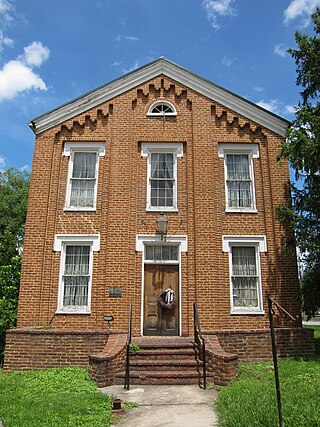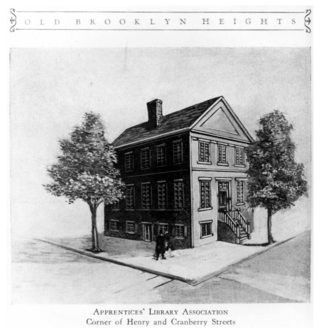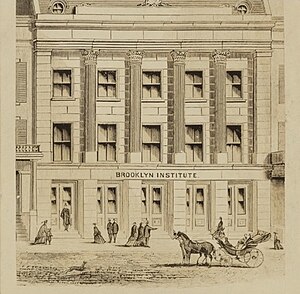
Ithiel Town was an American architect and civil engineer. One of the first generation of professional architects in the United States, Town made significant contributions to American architecture in the first half of the 19th century. His work, in the Federal and revivalist Greek and Gothic revival architectural styles, was influential and widely copied.

Thomas Ustick Walter was the dean of American architecture between the 1820 death of Benjamin Latrobe and the emergence of H. H. Richardson in the 1870s. He was the fourth Architect of the Capitol and responsible for adding the north (Senate) and south (House) wings and the central dome that is predominantly the current appearance of the U.S. Capitol building. Walter was one of the founders and second president of the American Institute of Architects. In 1839, he was elected as a member to the American Philosophical Society.

Richard Upjohn was a British architect who emigrated to the United States and became most famous for his Gothic Revival churches. He was partially responsible for launching the movement to popularity in the United States. Upjohn also did extensive work in and helped to popularize the Italianate style. He was a founder and the first president of the American Institute of Architects. His son, Richard Michell Upjohn, (1828-1903), was also a well-known architect and served as a partner in his continued architectural firm in New York.

James Renwick Jr. was an American architect in the 19th century, noted especially for designing churches and museums. The Encyclopedia of American Architecture calls him "one of the most successful American architects of his time".

The Old Campus is the oldest area of the Yale University campus in New Haven, Connecticut. It is the principal residence of Yale College freshmen and also contains offices for the academic departments of Classics, English, History, Comparative Literature, and Philosophy. Fourteen buildings—including eight dormitories and two chapels—surround a 4-acre (1.6 ha) courtyard with a main entrance from the New Haven Green known as Phelps Gate.

John Haviland was an English-born American architect who was a major figure in American Neo-Classical architecture, and one of the most notable architects working from Philadelphia during the nineteenth century.

The Albany Institute of History & Art (AIHA) is a museum in Albany, New York, United States, "dedicated to collecting, preserving, interpreting and promoting interest in the history, art, and culture of Albany and the Upper Hudson Valley region". It is located on Washington Avenue in downtown Albany. Founded in 1791, it is among the oldest museums in the United States.
The urban campus of New York University (NYU) is located in Manhattan, and is around Washington Square Park in Greenwich Village, and also is in MetroTech Center in Downtown Brooklyn. NYU is one of the top three largest landowners in New York City.

First Unitarian Congregational Society in Brooklyn is a Unitarian Universalist congregation in Brooklyn, NY. The Society was established in 1833 and has been worshiping in its historic Gothic Revival Sanctuary since 1844. The Sanctuary is adorned with stained glass windows and a Louis C. Tiffany angel mosaic. It is one of the earliest Unitarian congregations in the United States, established just 8 years after the American Unitarian Association was formed in 1825.

The General Society of Mechanics and Tradesmen of the City of New York is an educational and cultural association at 20 West 44th Street in Midtown Manhattan, New York City. It was founded on November 17, 1785, by 22 men who gathered in Walter Heyer's public-house at No. 75 King Street, one block from Wall Street, in Lower Manhattan. The aims of the General Society were to provide cultural, educational and social services to families of skilled craftsmen. The General Society during this early period celebrated the mutuality and centrality of the craft community. Besides its charitable activities, the society played a prominent part in the festivities that marked patriotic holidays, carrying banners emblazoned with its slogan 'By hammer and hand all arts do stand', echoing the motto of the Worshipful Company of Blacksmiths.

Literary Hall is a mid-19th-century brick library, building and museum located in Romney, a city in the U.S. state of West Virginia. It is located at the intersection of North High Street and West Main Street. Literary Hall was constructed between 1869 and 1870 by the Romney Literary Society.
The Second Unitarian Church in Brooklyn was a historic church in Cobble Hill, Brooklyn, New York City. It was built from 1857 to 1858 and was demolished in 1962. The Church became known as a prominent cultural center in Brooklyn. One of the church's members, Mary White Ovington, co-founded the NAACP, and the church was an abolitionist hub.

The Quad is an approximately 22-acre (8.9 ha) quadrangle on the campus of the University of Alabama located in Tuscaloosa, Alabama. Home to most of the university's original buildings, this portion of the campus remains the geographic and historic center of the modern campus. Originally designed by architect William Nichols, construction of the university campus began in 1828, following the move of the Alabama state capital from Cahaba to Tuscaloosa in 1826. The overall design for this early version of the campus was patterned after Thomas Jefferson's plan for the University of Virginia, with its Lawn and Rotunda. Following the destruction of the campus during the American Civil War, a new Quad emerged in the late 19th and early 20th centuries. Different in form and function from the original design of the early 19th century, the modern Quad continues to fill its role as the heart of the campus. Although surrounded by academic and administrative buildings, only five structures are built directly on the Quad: the Little Round House, Tuomey Hall, Oliver-Barnard Hall, Amelia Gayle Gorgas Library, and Denny Chimes. The remainder of the space is occupied by a grove of trees on the west side and a great lawn on the east. A feature on the northwestern side, known as The Mound, is the site of the old Franklin Hall. A popular gathering place, the Quad is home to pep rallies, a bonfire during homecoming, and numerous day-to-day student activities.

The Center for Fiction, originally called the New York Mercantile Library, is a not-for-profit organization in New York City, with offices at 15 Lafayette Avenue in Fort Greene, Brooklyn. Prior to their move in early 2018, The Center for Fiction was located at 17 East 47th Street, between Madison and Fifth Avenues in Midtown Manhattan. The center works to promote fiction and literature and to give support to writers. It originated in 1820 as the Mercantile Library and in 2005 changed its name to the Mercantile Library Center for Fiction, although it presents itself as simply "The Center for Fiction".
John Cunningham was a Scottish architect. He designed Lime Street railway station and the original Philharmonic Hall in Liverpool.
The League for Political Education was a New York City-based group devoted to providing a forum where people of every rank and station could be educated on the important issues of the day. Founded as a pro-women's suffrage group, the League initially fought for passage of the Nineteenth Amendment to the United States Constitution and provided general education on social and political issues. After opening up their membership to both genders, they later commissioned the building of The Town Hall and sponsored the long-running radio program America's Town Meeting of the Air. The League essentially dissolved in 1938 when it changed its focus to the daily operations of Town Hall.

The Brooklyn Apprentices' Library, also known as the Brooklyn Apprentices' Library Association, was the first circulating and free library established in the city of Brooklyn, New York. Founded in 1823, it was patterned after the Apprentices' Library of Philadelphia. The library moved from its original location in Brooklyn Heights to the Brooklyn Lyceum in 1841. In 1843 it merged with that organization to establish the Brooklyn Institute.
The Grand Opera House was a theatre in Brooklyn, New York that was in operation from 1881 through 1920. The theatre was demolished in 1924 along with several adjacent buildings to make room for the A. I Namm & Sons department store.













